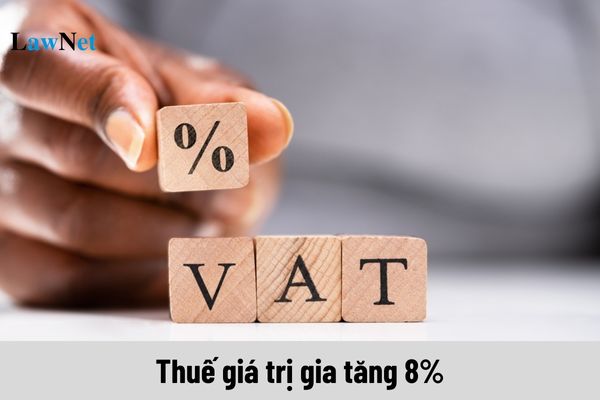Which goods and services are subject to the VAT rate of 8% in Vietnam?
Which goods and services are subject to the VAT rate of 8% in Vietnam?
The VAT rate of 8% is a reduced tax rate from the VAT rate of 10%, implemented to support business production and consumption according to Resolution 142/2024/QH15 (effective from August 13, 2024) and Decree 72/2024/ND-CP.
Specifically, according to Article 1 of Decree 72/2024/ND-CP, VAT on goods and services that are currently subject to 10% VAT shall be reduced, except the following goods and services:
- Telecommunication, financial activities, banking activities, securities, insurance, trading of real estate, metal and precast metal products, mining products (excluding coal mining), coke mining, refined oil, chemical products. Further details are provided in Appendix I enclosed with Decree 72/2024/ND-CP.
- Goods and services subject to excise tax. Further details are provided in Appendix II enclosed with Decree 72/2024/ND-CP.
- Information technology products and services as prescribed in the Law on information technology. Further details are provided in Appendix III enclosed with Decree 72/2024/ND-CP.
- VAT on goods and services of a specific type as specified in Clause 1 of this Article shall be reduced consistently in all stages, including import, production, processing and trading. Coal products mined for sale (including coal products mined and then washed, sieved and classified under a closed process before they are sold) are eligible for VAT reduction. Coal products in Appendix I enclosed herewith are not eligible for VAT reduction in any stages other than the mining stage.
Coal products produced under a closed process of economic corporations or groups shall be also eligible for VAT reduction.
In case any of the goods and services in Appendixes I, II and III enclosed with Decree 72/2024/ND-CP is not subject to VAT or is subject to 5% VAT in accordance with the Law on value-added tax, VAT on that good or service shall be paid in accordance with the Law on value-added tax and shall not be reduced.
Note: The application period for the VAT rate of 8% is until the end of December 31, 2024.

Which goods and services are subject to the VAT rate of 8% in Vietnam? (Image from the Internet)
What are the procedures for VAT reduction in Vietnam according to Decree 72/2024?
Under the provisions in Clause 3, Article 1 of Decree 72/2024/ND-CP on the procedures for VAT reduction as follows:
- For business establishments calculating VAT using the credit method:
When issuing VAT invoices for goods and services eligible for VAT reduction, write “8%” on the “VAT rate” line, VAT amount payable, and total amount payable by the buyer on the issued invoice.
The good seller or service provider shall declare output VAT and the good buyer or service user shall declare and deduct input VAT according to the VAT amount written on the VAT invoice.
- For business establishments (including household businesses and individual businesses) that pay VAT using the direct method (as a percentage (%) on revenue)
- When issuing sales invoices for goods and services on which VAT is reduced, write the amount before reduction in the "Thành tiền" ("Amount") column, the amount payable after reduction (by 20% of the tax rate on revenue) in the “Cộng tiền hàng hóa, dịch vụ” ("Total amount") line, and the note “đã giảm... (số tiền) tương ứng 20% mức tỷ lệ % để tính thuế giá trị gia tăng theo Nghị quyết số 142/2024/QH15” ("an amount of......., equivalent to 20% of the tax rate used as the basis for calculating VAT, is reduced according to Resolution 142/2024/QH15”) on the issued invoice.
If different VAT rates apply to different goods and services, the sales invoice must specify the reduced amounts.
If a business has already issued invoices and declared at the VAT rate or percentage rate that has not been reduced according to this Decree, the seller and the buyer must handle the issued invoices according to legal regulations on invoices and documents. Based on the adjusted invoices, the seller declares the adjustment of output tax, and the buyer declares the adjustment of input tax (if any).
How many methods for calculating VAT are there in Vietnam? What is the latest VAT calculation formula?
According to the provisions of the Value-Added Tax Law of 2008 and the current documents, VAT can currently be calculated by two methods:
- The credit method.
- The method of calculation of tax based directly on added value.
In principle, the general formula for calculating VAT is:
VAT = Taxable price x VAT rate
However, to appropriately apply VAT to each subject, VAT calculation will vary when applying the two VAT calculation methods.

